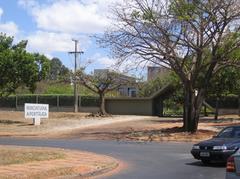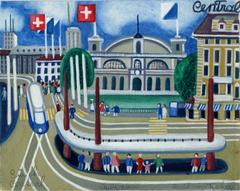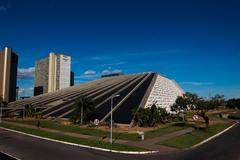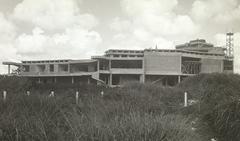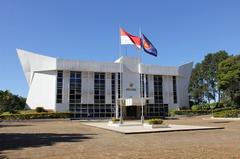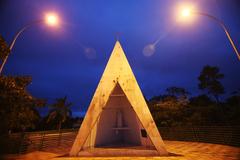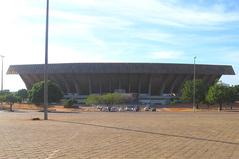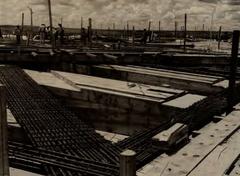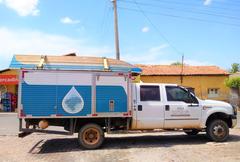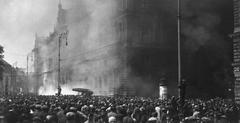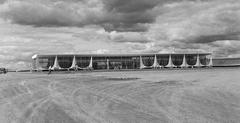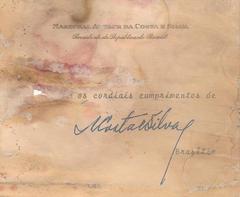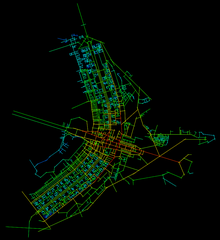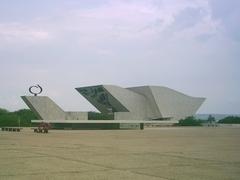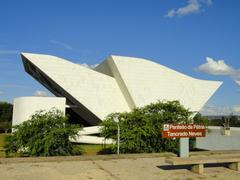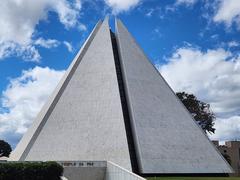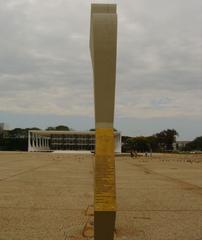Visiting Catedral Metropolitana Nossa Senhora Aparecida in Brasília: Hours, Tickets, and Tips
Date: 31/07/2024
Introduction to the Cathedral
The Catedral Metropolitana Nossa Senhora Aparecida, commonly known as the Brasília Cathedral, is an architectural marvel designed by the celebrated architect Oscar Niemeyer. Situated in the heart of Brazil’s capital city, Brasília, this iconic structure epitomizes modernist architecture and stands as a symbol of the nation’s innovative spirit and religious devotion. The cathedral’s unique hyperboloid design, supported by 16 parabolic concrete columns, creates an ethereal and futuristic appearance that captivates visitors from around the world (source).
Inaugurated on May 31, 1970, the Brasília Cathedral is not only a place of worship but also a cultural and artistic landmark. Its history is deeply intertwined with the broader narrative of Brasília, a planned city conceived by urbanist Lúcio Costa and architect Oscar Niemeyer, and inaugurated in 1960. The cathedral was one of the first monuments to be constructed in the city, making it a cornerstone of Brasília’s architectural and cultural landscape (Laidback Trip).
Visitors to the cathedral are greeted by an array of stunning artistic elements, including bronze sculptures by Alfredo Ceschiatti, stained glass windows by Marianne Peretti, and an altar donated by Pope Paul VI. The cathedral’s interior, bathed in natural light through its vibrant stained glass ceiling, offers a serene and meditative atmosphere that enhances its spiritual significance (Google Arts & Culture).
This comprehensive guide will provide you with detailed information on the history, architectural significance, visitor tips, and nearby attractions of the Brasília Cathedral. Whether you are an architecture enthusiast, a history buff, or a spiritual pilgrim, this guide aims to enrich your visit to one of Brazil’s most cherished landmarks.
Table of Contents
- Introduction
- History of Catedral Metropolitana Nossa Senhora Aparecida
- Visitor Information
- FAQ
- Significance and Legacy
- Nearby Attractions
- Visit and Stay Up to Date
- Conclusion
History of Catedral Metropolitana Nossa Senhora Aparecida
Architectural Genesis
The Catedral Metropolitana Nossa Senhora Aparecida, also known as the Brasília Cathedral, stands as a testament to modernist architecture and the visionary genius of Oscar Niemeyer. The cathedral was the first monument to be constructed in Brasília, with its cornerstone laid on September 12, 1958. The structural framework was completed by 1960, revealing a circular area with a diameter of 70 meters. This area is encircled by 16 concrete columns, each weighing 90 tons, designed in a hyperboloid shape. The structural calculations that made this ambitious design possible were executed by engineer Joaquim Cardozo (source).
Inauguration and Structural Elements
The cathedral was officially inaugurated on May 31, 1970. By this time, the external transparent glass panels were already in place, allowing natural light to flood the interior. The design of the cathedral is characterized by its unique hyperboloid structure, which gives it an ethereal and futuristic appearance. The 16 columns converge towards the top, creating a crown-like effect that is both striking and symbolic (source).
Artistic Contributions
The artistic elements within and around the cathedral are as significant as its architectural design. The entrance plaza features four bronze sculptures, each standing 3 meters tall, representing the Evangelists. These sculptures were crafted by Alfredo Ceschiatti, with assistance from Dante Croce (source).
Inside the nave, visitors are greeted by three suspended angel sculptures, also created by Alfredo Ceschiatti. These angels vary in size and weight: the smallest measures 2.22 meters in length and weighs 100 kg, the medium one is 3.40 meters long and weighs 200 kg, and the largest is 4.25 meters long and weighs 300 kg. These sculptures are suspended by steel cables, giving the impression that they are floating in mid-air (source).
Interior Design and Decorations
The interior of the cathedral is equally mesmerizing, featuring a stained glass ceiling composed of 16 pieces of fiberglass in shades of blue, green, white, and brown. These pieces are set between the concrete pillars, each forming a triangle with a 10-meter base and a height of 30 meters. This stained glass was designed by Marianne Peretti in 1990, adding a vibrant and colorful dimension to the cathedral’s interior (source).
The altar, a focal point within the cathedral, was donated by Pope Paul VI. It is complemented by a replica of the image of Nossa Senhora Aparecida, the patron saint of Brazil, whose original statue is housed in Aparecida, São Paulo. The Via Sacra, a series of artworks depicting the Stations of the Cross, was created by Di Cavalcanti, adding to the spiritual and artistic richness of the cathedral (source).
Additional Artistic Features
The cathedral also houses a baptistery with an ovoid shape, featuring a ceramic tile panel painted in 1977 by Athos Bulcão. The bell tower, consisting of four large bells donated by Spain, completes the architectural ensemble. At the entrance, a pillar adorned with scenes from the life of Mary, mother of Jesus, also painted by Athos Bulcão, welcomes visitors (source).
Visitor Information
Opening Hours
The cathedral is open to visitors daily, but it is advisable to check the official website for any changes in timings or special events (source).
Guided Tours
Consider taking a guided tour to fully appreciate the architectural and artistic details.
Photography
Photography is allowed, but be respectful of worshippers and avoid using flash during services.
Accessibility
The cathedral is wheelchair accessible, ensuring that all visitors can enjoy its beauty.
Donations
Contributions to the maintenance of this cultural and religious heritage site are welcome and can be made on-site or through the official website (source).
FAQ
What are the visiting hours of the Brasília Cathedral? The cathedral is open daily, but it is best to check the official website for current visiting hours.
How much are the tickets for the Catedral Metropolitana Nossa Senhora Aparecida? Entrance to the cathedral is generally free, though donations are appreciated.
Is the Brasília Cathedral accessible for wheelchairs? Yes, the cathedral is wheelchair accessible.
Significance and Legacy
The Catedral Metropolitana Nossa Senhora Aparecida is not just an architectural marvel but also a symbol of faith and cultural heritage for the people of Brazil. Its design and construction reflect the innovative spirit of Brasília, a city that was planned and built to serve as the new capital of Brazil. The cathedral’s unique structure and artistic elements make it a must-visit landmark for tourists and a cherished place of worship for locals.
Nearby Attractions
While visiting the cathedral, consider exploring nearby attractions such as the National Congress of Brazil, the Itamaraty Palace, and the Juscelino Kubitschek Memorial to make the most of your trip to Brasília.
Visit and Stay Up to Date
For the latest updates, special events, and more information, visit the cathedral’s official website or follow their social media channels. Download the mobile app Audiala for a more interactive experience and to explore other related posts.
Conclusion
The Catedral Metropolitana Nossa Senhora Aparecida is more than just an architectural wonder; it is a symbol of faith, cultural heritage, and the innovative spirit that defines Brasília. Designed by Oscar Niemeyer and inaugurated in 1970, the cathedral’s hyperboloid structure and artistic features make it a must-visit destination for anyone traveling to Brazil’s capital (Pilgrim Info).
From its inception, the Brasília Cathedral has captivated visitors with its unique design and spiritual ambiance. The architectural genius of Niemeyer, combined with the artistic contributions of Alfredo Ceschiatti, Marianne Peretti, and others, creates a space that is both awe-inspiring and deeply moving. The cathedral’s stained glass ceiling, suspended angel sculptures, and bronze statues of the Evangelists are just a few of the elements that contribute to its lasting impact (ArchDaily).
As you explore the cathedral, take the time to appreciate its integration with the surrounding environment and its role in the broader context of Brasília’s development. Nearby attractions such as the National Congress of Brazil, the Itamaraty Palace, and the Juscelino Kubitschek Memorial further enrich your visit, offering additional insights into the city’s architectural and cultural landscape (Visite Brasília).
In conclusion, the Brasília Cathedral stands as a testament to Brazil’s commitment to innovation, faith, and artistic excellence. Whether you are drawn by its architectural significance, its cultural heritage, or its spiritual resonance, a visit to the Catedral Metropolitana Nossa Senhora Aparecida is an unforgettable experience that will leave a lasting impression.
